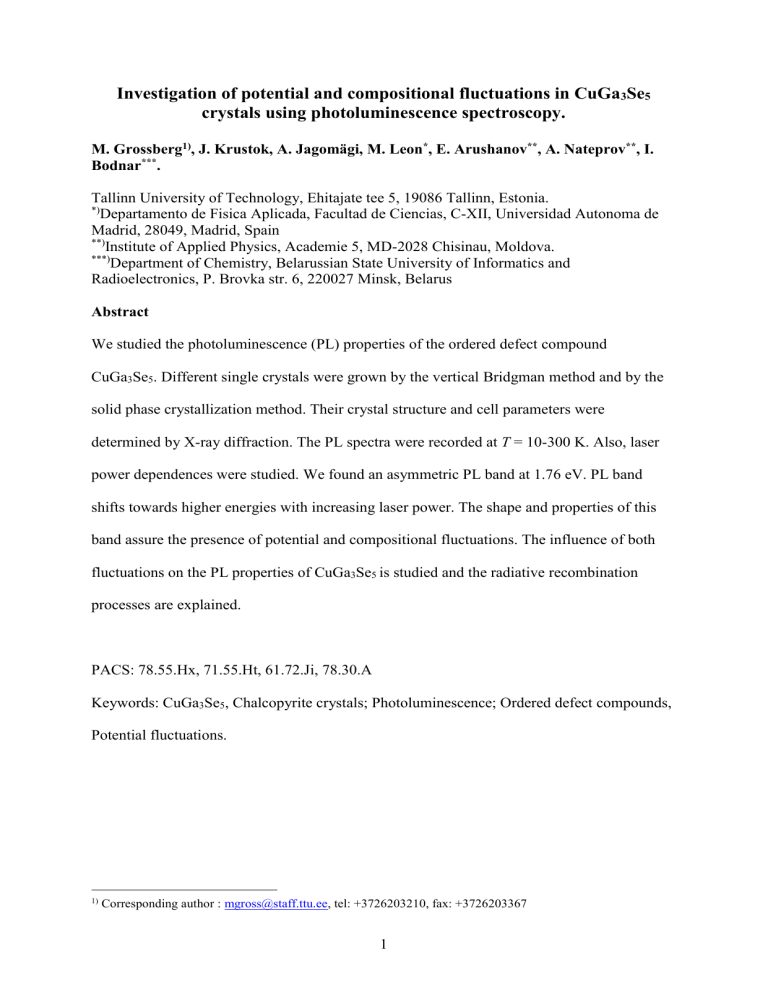Grossberg paper

Investigation of potential and compositional fluctuations in CuGa
3
Se
5
crystals using photoluminescence spectroscopy.
M. Grossberg 1) , J. Krustok, A. Jagomägi, M. Leon * , E. Arushanov ** , A. Nateprov ** , I.
Bodnar *** .
Tallinn University of Technology, Ehitajate tee 5, 19086 Tallinn, Estonia.
*) Departamento de Fisica Aplicada, Facultad de Ciencias, C-XII, Universidad Autonoma de
Madrid, 28049, Madrid, Spain
**)
Institute of Applied Physics, Academie 5, MD-2028 Chisinau, Moldova.
***)
Department of Chemistry, Belarussian State University of Informatics and
Radioelectronics, P. Brovka str. 6, 220027 Minsk, Belarus
Abstract
We studied the photoluminescence (PL) properties of the ordered defect compound
CuGa
3
Se
5
. Different single crystals were grown by the vertical Bridgman method and by the solid phase crystallization method. Their crystal structure and cell parameters were determined by X-ray diffraction. The PL spectra were recorded at T = 10-300 K. Also, laser power dependences were studied. We found an asymmetric PL band at 1.76 eV. PL band shifts towards higher energies with increasing laser power. The shape and properties of this band assure the presence of potential and compositional fluctuations. The influence of both fluctuations on the PL properties of CuGa
3
Se
5 is studied and the radiative recombination processes are explained.
PACS: 78.55.Hx, 71.55.Ht, 61.72.Ji, 78.30.A
Keywords: CuGa
3
Se
5
, Chalcopyrite crystals; Photoluminescence; Ordered defect compounds,
Potential fluctuations.
1) Corresponding author : mgross@staff.ttu.ee
, tel: +3726203210, fax: +3726203367
1
1. Introduction
CuGaSe
2
and the related I-III-VI
2
chalcopyrite compounds are of great interest due to their potential in photovoltaic and nonlinear optical applications. Another attractive property is their tolerance to large range of anion-to-cation off stoichiometry, manifested by the existence of an ordered defect compounds (ODC) with large variations in their Cu/Ga/Se ratio
[1]. These ODCs, like CuGa
3
Se
5
and CuGa
5
Se
8
, generally possess wider bandgap and the formation of ternary Cu-Ga-Se compounds with varying bandgaps enables the formation of heterojunctions used in the design of high-performance electronic and optoelectronic devices.
The bandgap energy of CuGa
3
Se
5 for bulk samples at room temperature is 1.754 eV and for thin films 1.855 eV [2].
Rincon et al . [3] have measured the PL spectrum of CuGa
3
Se
5
that consists of one broad band hν max
= 1.63 eV ( T = 15 K) that is proposed to result from donor-acceptor pair recombination. Guastavino et al . [4] have measured the PL spectrum of CuGa
3
Se
5
that consists of one broad asymmetric edge emission band at hν max
= 1.6 eV ( T = 4.2 K) and one deeper band at hν max
~ 1.2 eV ( T = 4.2 K). The broadness of the PL bands (150–200 meV) was interpreted also by donor-acceptor pair transitions.
At the same time, the asymmetric shape of the PL band in ternary chalcopyrites is often caused by the band tails induced by potential fluctuations due to the high concentration of intrinsic defects [5, 6, 7]. Furthermore, compositional fluctuations also affect the shape of
PL bands by creating the fluctuations of the bandgap energy. In this paper, we study the photoluminescence (PL) properties of CuGa
3
Se
5
in connection with compositional and potential fluctuations.
2
2. Experimental
The CuGa
3
Se
5
crystals were grown by the solid phase crystallization (SPC) method and vertical Bridgman method. For the SPC growth, the stoichiometric amounts of Cu
(99.999% of purity), Ga (99.9999%) and Se (99.999%) (~20g total) were placed together in quartz ampoule with an inner surface coated by carbon. Ampoule was evacuated up to 10
2
Pa and sealed. For synthesis, one-zone vertical resistance furnace was used. Ampoule with Cu,
Ga, and Se was heated up to 550-600 o
C and kept at this temperature for 24 hours. Then, the temperature was raised with the rate of 50 K/h up to 950 o
C. This temperature is about 30 o
C lower than the melting point temperature of CuGa
3
Se
5
( T m
=1359 K [8]). Ampoule was held at this temperature for 10 days before cooling. An ingot consisting of a few single crystal blocks of CuGa
3
Se
5
was obtained.
For the Bridgman growth, crystals with given composition grown by the twotemperature method were used. The details of the growth can be found in [8].
For the structural characterization, X-ray diffraction (XRD) patterns, recorded by the
Siemens D 500 diffractometer were used. The composition of the crystals was determined by energy- dispersive X-ray analysis (EDAX) performed on the Leo Supra 35 SEM. PL measurements were done using closed-cycle He cryostat ( T = 8-300 K) and He-Cd laser
(441.6 nm) as an excitation source.
3. Results and discussion
3.1 Structural analysis.
The phases and crystallographic structure of the crystals were determined by X-ray diffraction. Rietveld method was used for the derivation of crystal structure information from powder XRD data. The X-ray analysis demonstrated the single phase of the tetragonal chalcopyrite-related structure of CuGa
3
Se
5
. The Rietveld evaluation produced unit-cell
3
parameters a = 0.54874 nm, and c = 1.10049 nm for CuGa
3
Se
5
crystal grown by the SPC method and a = 0.54803 nm, and c = 1.09734 nm for the crystal grown by the vertical
Bridgman method. These values are close to data a = 0.544995(8) nm, and c = 1.0946(3) nm reported in Ref. [9].
3.2 Composition analysis.
The studies of the crystals` composition were done by energy-dispersive X-ray analysis (EDAX). The chemical composition was measured in several points of crystals and the presence of compositional fluctuations was detected, being larger for the CuGa
3
Se
5 samples grown by the SPC method, see Fig.1.
3.3 Photoluminescence results
In heavily doped semiconductors Coulomb potential fluctuations are induced due to the random distribution of unscreened charged defects. These potential fluctuations will lead to a local perturbation of the band structure, thus broadening the defect level distribution and forming band tails [10, 11]. Radiative recombination in heavily doped crystal is therefore governed by the recombination of carriers localized in spatially separated potential wells originating from Coulomb potential fluctuations. The presence of compositional fluctuations causes additional broadening of the PL bands due to the variation of the bandgap energy, see
Fig. 2.
In this study, we found a broad (full width at half maximum (FWHM) ~ 200 meV) asymmetric PL band at 1.76 eV. It has an exponential slope on the low-energy side and steeper Gaussian incline on the high-energy side. This type of asymmetric PL bands were found in many ternaries [5-7, 13]. Fig. 3 shows normalised spectra of the asymmetric PL band for SPC grown CuGa
3
Se
5
, measured from different points of the crystal. The maximum
4
energy difference of the corresponding peak positions is ~60 meV. This difference may be taken as the approximate value of the bandgap energy fluctuations. The mean amplitude of the
Coulomb potential fluctuations
γ
0
is the average energetic difference between the hole energy in the Coulomb potential fluctuation minimum and maximum, see Fig. 2. The average amplitude of band edge fluctuations
γ *
in the presence of potential and compositional fluctuations is the mean difference of the energy of holes in the valence band fluctuation minimum and maximum. The slope of the low-energy side of the PL band is determined by the density of states in the valence band and therefore depends on the amplitude of both fluctuations. Thus, the values of the mean amplitude of the band edge fluctuations γ * can be derived form the slope of the low-energy side of the PL band [5, 6, 10]. The compositional fluctuations also affect the half-width of the PL-band. The values of the mean amplitude of the band edge fluctuations
γ *
and the FWHM of the BT-band for several chalcopyrite compounds is shown in Table 1. The average value of
γ *
of the crystals investigated in this study has been determined from the exponential slope of the low-energy side of the PL-band
(see Fig. 2) and was about 70 meV, and 90 meV for Bridgman, and SPC grown CuGa
3
Se
5
, respectively. These rather high values of
γ *
and FWHM support the idea of the coexistence of potential and compositional fluctuations in these samples.
Excitation power and temperature dependent photoluminescence measurements indicate that our spectra are dominated by the BT-type recombination that involves free electron and a hole that is localized in the valence band tail. Due to their small effective mass
m e
*
0 .
08 m e
, almost all electrons are free. Due to band edge fluctuations, at low temperatures, holes in the valence band can not be considered as free like in the undisturbed crystal with flat bands (graphical illustration and theoretical discussion of this kind of configuration is presented in [7] and [10]). Holes are localized in the valence band potential wells and form so-called pseudo acceptor states. The activation energy of the thermal
5
quenching of the BT-band allows us to evaluate the average depth of these pseudo- acceptor states. From Arrhenius plot of thermal quenching of the PL bands, we obtained thermal activation energies 38
12 meV, and 53
17 meV for Bridgman, and SPC crystals, respectively. Although, the lnI(T) versus 1000/T dependence is very similar to the theoretical dependence for discrete energy levels [12], it is clear that in the case of BT type recombination, the fitting is not completely valid due to continuous tail states. However, the average activation energy of pseudo- acceptor states can be estimated to be approximately 45 meV.
In Fig. 4, the temperature dependence of the peak position of the 1.76 eV PL band is shown along with the bandgap energy E g
of CuGa
3
Se
5
[2]. The observed shift of the peak position energy exceeds the temperature dependence of the bandgap energy. This feature is predicted by the theory of heavily doped semiconductors [6,10]. According to the theory, when holes, localized in the valence band tail are freed at higher temperatures, BB-transition, that involves a free electron and a free hole, dominates the spectra. However BB-band may not appear in the presence of large compositional fluctuations, because higher thermal energy is needed to liberate holes. In our case, the thermal energy is enough to redistribute the holes between the potential wells and therefore BB-band was not detected.
The excitation power dependence of the PL peak at 1.76 eV is shown in Fig. 5. The blue shift of the BT-band with the magnitude of about 19 meV per decade was detected. This confirms that the observed emission results from BT recombination together with the bandgap fluctuations [6,10].
The detailed theoretical discussion of these results is beyond the scope of this paper and will be presented in the near future.
6
4. Conclusions.
The photoluminescence properties of the ordered defect compound CuGa
3
Se
5 have been studied. Broad asymmetric PL band at 1.76 eV, resulting from BT-type recombination, has been detected. The shape and the properties of this PL band were explained assuming the coexistence of compositional fluctuations and the potential fluctuations due to high concentration of charged defects. The energy dispersive X-ray analysis confirmed the variation of composition in the samples.
Aknowledgements
This work was supported by INTAS grant nr. 03-51-6314 and by the Estonian Science
Foundation grant G-6554.
References:
[1] S.B. Zhang, S.H. Wei, A. Zunger, Phys. Rev. B 57 (1998) 9642.
[2] G. Marin, C. Rincon, S.M. Wasim, G. Sanchez Perez, I. Molina, J. Alloys and Comp.
283 (1999) 1.
[3] C. Rincon, S.M. Wasim, G. Marin, E. Hernandez, G. Sanchez Perez, J. Galibert, J.
Appl. Phys. 87 (2000) 2293.
[4] F. Guastavino, K. Zeaiter, L. Djellal, Yanuar, D. Bayaa, M. Abdelali, C. Llinares,
Solid State Phenomena 67-68 (1999) 427.
[5] J. Krustok, H. Collan, M. Yakushev, K. Hjelt, Physica Scripta T79 (1999) 179.
[6] J. Krustok, J. Raudoja, M. Yakushev, R.D. Pilkington, H. Collan, phys. stat. sol. (a)
173 (1999) 483.
[7] A. Jagomägi, J. Krustok, J. Raudoja, M. Grossberg, M. Danilson, M. Yakushev,
Physica B 337 (2003) 369.
7
[8] N.S. Orlova, I.V. Bodnar, T.L. Kushner, J. Phys. Chem. Solids 64 (2003)1895.
[9] S.M. Wasim, C. Rincon, G. Marin, R. Marquez, G. Sanchez Perez, R. Guevara, J. M.
Delgado, L. Nieves, Mat. Res. Soc. Symp. Proc. 668 (2001) H1.2.1.
[10] A.P. Levanyuk, V.V. Osipov, Soviet Phys. Uspekhi 133 (1981) 443.
[11] B.I. Shklovskij, A.L. Efros, Electronic Properties of Doped Semiconductors,
Springer, Berlin, 1984.
[12] J. Krustok, H. Collan, K. Hjelt, J. Appl. Phys. 81 (1997) 1442.
[13] J. Krustok, A. Jagomägi, M. Grossberg, J. Raudoja, M. Danilson, Solar Energy
Mater. Solar Cells (in press, available online 23 March 2006).
8
Fig.1. Chemical composition measured in several points of CuGa
3
Se
5
crystals grown by the
SPC method (left) and by the vertical Bridgman method (right). The dashed line represents the chemical composition of CuGa
3
Se
5
(Cu:Ga:Se = 11.11:33.33:55.55 at.%).
9
Fig.2. BT recombination model in CuGa
3
Se
5
in the presence of potential and compositional fluctuations. BT
1
and BT
2
emissions originate from different parts of the crystal with different bandgap energy ( E g1
vs E g2
).
10
Fig.3. Normalised spectra of the 1.76 eV PL band for SPC grown CuGa
3
Se
5
, measured from different spots of the crystal. The energy difference of the peak positions is ~ 60 meV. The exponential slope of the low-energy side of the BT-band gives the average depth of the band edge fluctuations
γ *
.
11
Fig.4. Temperature dependence of the peak position of the 1.76 eV PL band and the bandgap energy E g
[2] of CuGa
3
Se
5
.
12
Fig. 5. The laser power dependence of PL spectrum of the CuGa
3
Se
5
crystal grown by the vertical Bridgman method. The observed PL band shifts to higher energies with increasing excitation intensity. The magnitude of the shift is about 19 meV per decade.
13
Figure captions
Fig.1. Chemical composition measured in several points of CuGa
3
Se
5
crystals grown by the
SPC method (left) and by the vertical Bridgman method (right). The dashed line represents the chemical composition of CuGa
3
Se
5
(Cu:Ga:Se = 11.11:33.33:55.55 at.%).
Fig.2. BT recombination model in CuGa
3
Se
5
in the presence of potential- and compositional fluctuations. BT
1
and BT
2
emissions originate from different parts of the crystal with different bandgap energy ( E g1
vs E g2
).
Fig.3. Normalised spectra of the 1.76 eV PL band for SPC grown CuGa
3
Se
5
, measured from different spots of the crystal. The energy difference of the peak positions is ~ 60 meV. The exponential slope of the low-energy side of the BT-band gives the average depth of the band edge fluctuations
γ *
.
Fig.4. Temperature dependence of the peak position of the 1.76 eV PL band and the bandgap energy E g
[2] of CuGa
3
Se
5
.
Fig. 5. The laser power dependence of PL spectrum of the CuGa
3
Se
5
crystal grown by the vertical Bridgman method. The observed PL band shifts to higher energies with increasing excitation intensity. The magnitude of the shift is about 19 meV per decade.
14
Table 1. Values of the average amplitude of the band edge fluctuations
γ *
, calculated from the low-energy slope of the PL band, and FWHM of the BT-band for several chalcopyrite compounds.
Compound
CuGaSe
2
CuIn
0.5
Ga
0.5
AgGaTe
CuInSe
2
2
Se
2
CuGa
3
Se
5
(Bridgman)
CuGa
3
Se
5
(SPC)
γ
(meV)
17.6
17.0
4.5
24.1
58.1 - 72.8
71.4 - 94.5
FWHM (meV)
50
49
16
51
170 - 178
188 - 220
References
[6]
[5]
[13]
Our data
Present work
Present work
15







